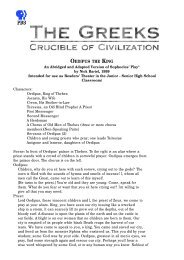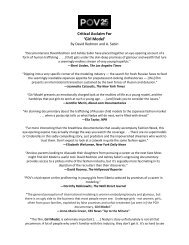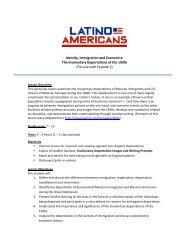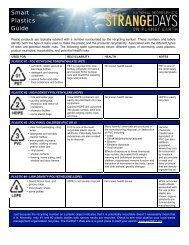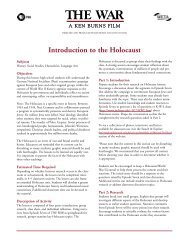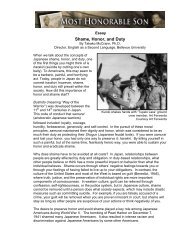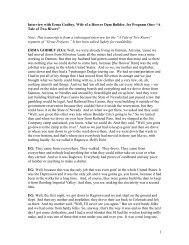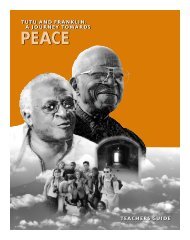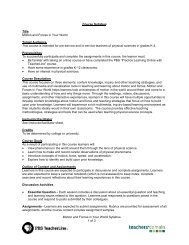<strong>Episode</strong> 9, <strong>2003</strong>: <strong>Revolutionary</strong> <strong>War</strong> <strong>Poem</strong><strong>Salem</strong>, <strong>Oregon</strong>“For those ruffians of Britain’s by thousands did come to slay the boys of Boston in the western land. Nowthe people of America did assemble and agree to drive them from the land that is called liberty.”The poem makes other references to New England, so we’ve decided to begin our investigation in Boston,Massachusetts.Elyse: As Gwen sets off to investigate Goodhue, the man, I’m taking the poem to Stewart Whitehurst at therare manuscripts department of Skinner auction house. I’m hoping he can help me authenticate the poem as18th century. It’s dated 1780, you know, and it feels old to me. It looks period to me, but I need your expertopinion. It’s a great first step. Does it feel old? Does it -- does it give you that little tingle?Stewart: Let’s get the light box on. Now, have you looked to see if there’s a watermark -- no. You havenot. Well, a watermark actually is an indication of who may have made the paper, which can provide veryimportant clues, as to date, authenticity, that sort of thing. Let’s look here. Will be something asymmetrical,something different. There it is. See that little shaped half circle there?Elyse: Absolutely.Stewart: It’s actually a partial watermark.Elyse: Little half circle. I never would have noticed that.Stewart: See if we can identify what it might be. And it is indistinguishable. So I don’t know if we’re going tobe able to get much information off of it.Elyse: Without a watermark, Stewart isn’t able to date the paper precisely, but there are other methods. It’sdated 1780. Now what you would expect to find on a piece of paper that’s made in 1780 is that it’s made ofwhat we call laid paper.Stewart: Okay, now, we’re looking for those strong lines that are going vertically. Those are some main chainlines. And then all the smaller cross lines that are going across, that is your absolutely typical pattern thatyou would expect to find on laid paper.Elyse: Now, talk to me about the style of the handwriting.Stewart: There are a couple of affectations that you find, at least in 18th-century writing, that kind of go bythe wayside in the 19th century. What appears to be an “f” to our eyes now which is actually an “s,” so itlooks like, let’s see if we can find any one in here. Ah, perfect. Here we go. If you look right here, it says,“Those ruffians.” Look at that. See, there it is. Instead of an “s,” it actually looks more like an “f.” okay, that’s-- absolutely. That would be considered a pretty strong 18th century -- that’s incredible. All in all, you put thepackage together, certainly looks like it could be from 1780.Elyse: That’s just what I wanted to hear. Excellent.Gwen: I’m starting my investigation into our poet at the Massachusetts historical society. I’m hoping theirarchives hold some evidence about Daniel Goodhue’s life. This is volume 6, names f and g, of “Sailorsand Soldiers of the <strong>Revolutionary</strong> <strong>War</strong> from the Colony of Massachusetts.” If Daniel Goodhue was fromMassachusetts and he served in the <strong>Revolutionary</strong> <strong>War</strong>, his name will be in here.Get more on History Detectives at: www.pbs.org/historydetectives© 2006 <strong>Oregon</strong> Public Broadcasting all rights reserved
<strong>Episode</strong> 9, <strong>2003</strong>: <strong>Revolutionary</strong> <strong>War</strong> <strong>Poem</strong><strong>Salem</strong>, <strong>Oregon</strong>Ah, here’s the page for Goodhues. Immediately, I notice that there are multiple spellings of the nameGoodhue and three Goodhues with the first name Daniel. Obviously, it was a fairly common name andthere’s nothing here that suggests that any of these men were captured and put in a prison. So I don’t knowif Daniel Goodhue, our poet, is one of these people. I need a different strategy. I’m running out of sources.There may be a reference to Mill Prison in this book, “Mariners of the American Revolution.” Here’s a noteon the prisons where the American rebels were brought. “Mill Prison at Plymouth, England.” So the sailors,the American sailors who were captured were taken to England and imprisoned there. So that’s one mysterysolved. The Mill Prison that our poet speaks of really did exist, but it was about 3,000 miles away acrossthe Atlantic. Now, let me see if Daniel Goodhue is listed here as a sailor who was captured. Here he is.Daniel Goodhue of Ipswich, captured aboard the “Fancy,” August 7, 1777. This must be our man. I think wehave some important facts in place now. We know that Daniel Goodhue existed. He came from Ipswich,Massachusetts. He was captured aboard the “Fancy” and taken to Mill Prison in Plymouth, England. IfGoodhue was captured aboard a ship, then he must have been a sailor. I need to find out more about hisservice aboard the “Fancy.” I’ve come to the navy history center in Washington, D.C., to consult with thedirector of the early history branch. I know that Daniel Goodhue was a sailor, so I’m hoping that Dr. MichaelCrawford can tell me more about Goodhue’s role in the war and how he landed in Mill Prison. He wascaptured aboard a ship called the “Fancy.” do you know something of the history of that ship? Was it one ofthese early navy ships?Michael: The “Fancy” was not a continental navy ship. They all had names like “Tyrannicide” or “Defense” or“Revenge” or something like that. “Fancy” is not a warship’s name. It’s likely it was a privateer. At the startof the war in 1775, general George Washington knew that, in order to defeat the British, he had to assemblea navy out of nothing. So the general commissioned privateers, mainly merchant ships for hire, to attackand seize incoming British supplies and trade. And here Dr. Crawford discovers a record of the British shipscaptured by Goodhue’s privateer.Michael: The “Brunswick,” the “Cleveland,” the “Kanoul,” the “Dillon,” and an unidentified sloop.Gwen: So with five British ships that she captured, Daniel Goodhue’s ship, the “Fancy,” made a realcontribution to the war effort?Michael: She really was a successful cruise until she got caught. “Was captured between silly and ushent.”On August 6, 1777, Goodhue’s ship was 20 miles off the coast of England, preying on British merchantvessels. Two hours before dawn they were spotted by a heavily armed British warship. Vastly overpowered,they had no choice but to flee. A 28-hour chase ensued. The “Fancy” made several desperate attemptsto get away, including dumping 9 of its 12 cannons overboard to gain speed. At 8:30 the next morning,they were fired upon. The entire crew abandoned ship and made for the shoreline. But they were soonoverwhelmed by British marines. 56 men, including Daniel Goodhue, were captured and taken to Mill Prison,where they joined about 1200 other prisoners of war.Gwen: Can you give me an overall sense of what conditions were like in Mill Prison?Michael: It was a hard life. The food was bad. They usually were given bad meat and moldy cheese. Poorfood led to bad nutrition, which, given the crowded conditions, also led to disease. So given the disease andthe malnutrition and the general conditions, many of the men must have died in prison.Gwen: Is that right?Get more on History Detectives at: www.pbs.org/historydetectives© 2006 <strong>Oregon</strong> Public Broadcasting all rights reserved





